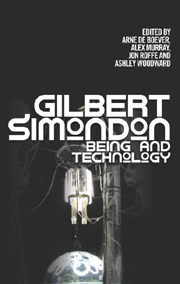Book contents
- Frontmatter
- Contents
- Abbreviations
- Editors' Introduction: Simondon, Finally
- 1 Technical Mentality
- Explications
- Implications
- 5 The Question of Anxiety in Gilbert Simondon
- 6 Infra-Psychic Individualization: Transductive Connections and the Genesis of Living Techniques
- 7 ‘Du mort qui saisit le vif’: Simondonian Ontology Today
- 8 The Aesthetics of Gilbert Simondon: Anticipation of the Contemporary Aesthetic Experience
- Resonances
- Glossary: Fifty Key Terms in the Works of Gilbert Simondon
- Notes on Contributors
- Index
6 - Infra-Psychic Individualization: Transductive Connections and the Genesis of Living Techniques
from Implications
Published online by Cambridge University Press: 12 September 2012
- Frontmatter
- Contents
- Abbreviations
- Editors' Introduction: Simondon, Finally
- 1 Technical Mentality
- Explications
- Implications
- 5 The Question of Anxiety in Gilbert Simondon
- 6 Infra-Psychic Individualization: Transductive Connections and the Genesis of Living Techniques
- 7 ‘Du mort qui saisit le vif’: Simondonian Ontology Today
- 8 The Aesthetics of Gilbert Simondon: Anticipation of the Contemporary Aesthetic Experience
- Resonances
- Glossary: Fifty Key Terms in the Works of Gilbert Simondon
- Notes on Contributors
- Index
Summary
In the biotechnological age, life has taken a dramatic form; today's life is not only concerned with technology, it co-emerges with it. Contemporary biotechnological interventions create intelligent machines, responsive materials, hybrids, cyborgs, semi-living beings, partial life, chimeras: all categories referring to monstrous entities whose demonstrations orchestrate our evolutionary dis/continuities – all kinds of biotechnical individuals. By foregrounding the relationships between life, technique and the environment, I investigate here the potential for the integration of life's materials and processes into design practices that give rise to what I call living techniques or techniques of bringing to life (techniques du faire vivant). Living techniques amount to life's operational and creative identity by raising the question of the level of complexity at which life presents itself as an emerging property. Central to this question is these living techniques' political field of emergence: that is, living techniques' potential to discover new goals in the course of their becoming as well as to invent new forms of actions to achieve these goals. The complex relationships between perception and action are therefore at stake.
Gilbert Simondon's thought holds great potential to think – or rethink – the political relations entangled in the process of coupling life's materials and processes with technology. One could argue that contemporary debates about biotechnology combine the two principal themes of Simondon's work: (1) the modes of existence of technical objects and (2) the concept of individuation. A key aspect of his thought revolves around the application of the concept of the individual to that of the technical object.
- Type
- Chapter
- Information
- Gilbert SimondonBeing and Technology, pp. 92 - 109Publisher: Edinburgh University PressPrint publication year: 2012



